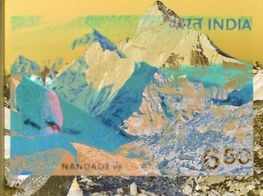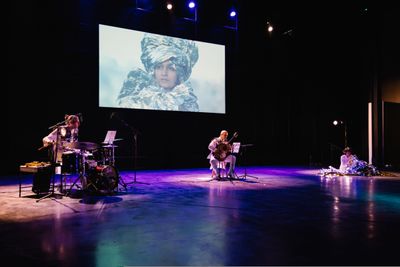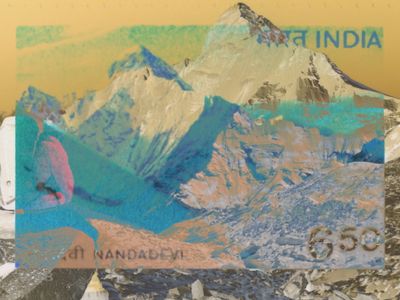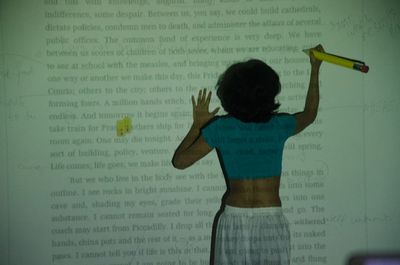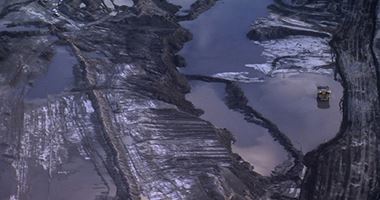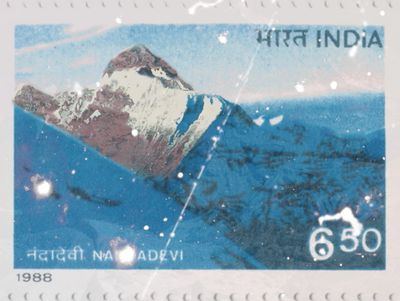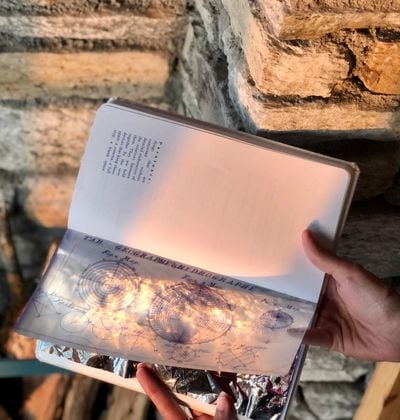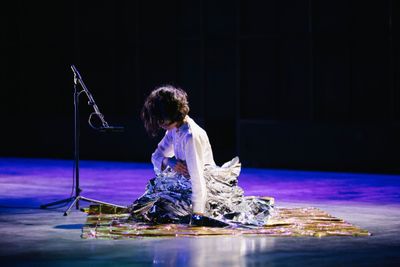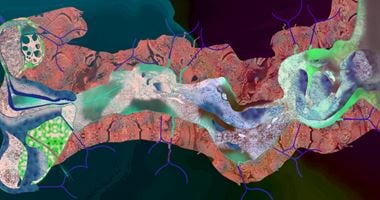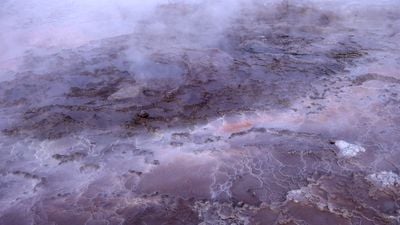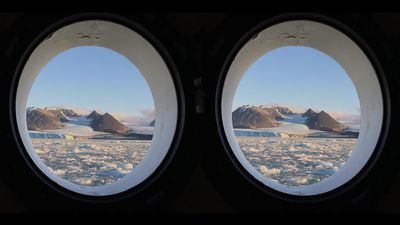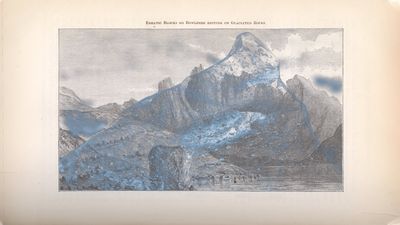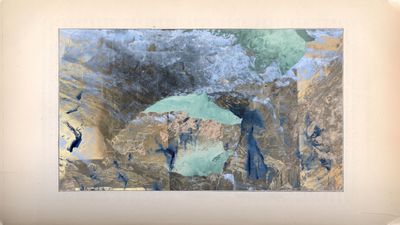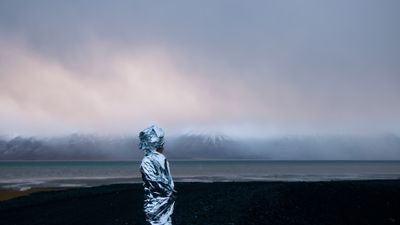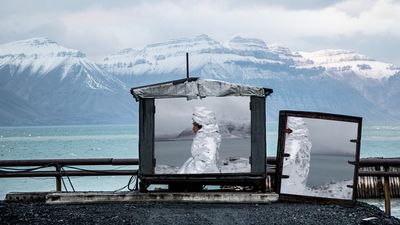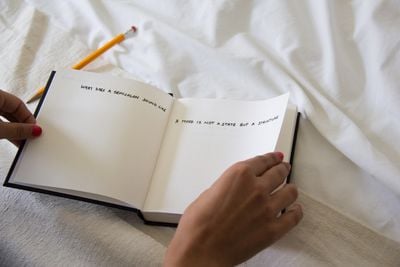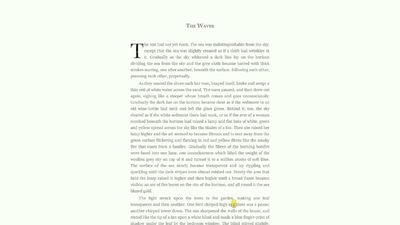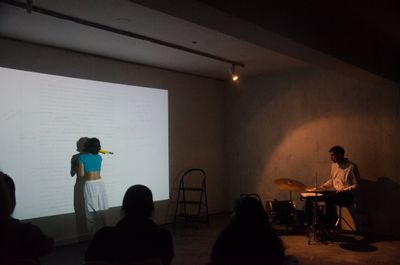Himali Singh Soin's Planetary Practice
Courtesy the artist.

Courtesy the artist.
Himali Singh Soin dissects the environments around and beyond her by amassing materials—literary, archival, anecdotal—to metaphorically reflect on human engagement and disengagement with the natural world.
But Soin isn't dogmatic. Rather, the artist suffuses her work with the many paradoxes of the human relationship with the non-human spheres. As if to match these incoherent responses, she bucks and bounds across media and creates large projects that incorporate interlinked films, performances, and audio made with a host of collaborators.
Within this approach, writing is fundamental, and text is her anchor. She is well published, and currently the Whitechapel Gallery Writer in Residence, where she has produced a collection of 'flash fictions', titled ancestors of the blue moon. Narrated from the perspective of Himalayan deities from pre-animistic, Bon, and Tibetan Buddhist traditions, the fictions form themselves around stills from her three-channel video as grand as what (2018–2020).
Soin has inserted herself, quite literally, into words before. In her video and performance, The Particle and the Wave (2015), included in the group show Syncopes at Mimosa House in London opening this spring pending U.K. lockdown measures, Soin's body merges with Virginia Woolf's novel, The Waves (1931). In front of a slow rolling projection of the whole text accompanied by live drum improvisation and a soundtrack, she adds marginalia that strike up a conversation with Woolf.
Each section of text stays projected for as long as each of the 1,265 semicolons is highlighted. Progressively, they are abstracted from the stream of writing to the point where they're anthropomorphised and less indicative of a pause, now more a character. Soin's grammatical fanaticism finds its way into the soundtrack, composed by algorithm based on the spacing between each appearance of the mark.
Codes and patterns wind around a central logic and principle throughout Soin's practice. Take we are opposite like that (2017–2022), a project based on her expeditions to the high Arctic and Antarctic circles that has been shown, in parts, at Gropius Bau, Berlin; Dhaka Art Summit; Anchorage Museum, Alaska; and Concrete, Dubai. This trip has expanded, and like a scattered Gesamtkunstwerk, includes a film—produced as a result of her receipt of the 2019 Frieze Artist Award—an exquisite pseudo-almanac, performances, prints, and sound installations.
Her experience in these extreme regions has stimulated a tangle of connections mediated by the ice, where mythology meets colonial history, and contemporary environmental concerns are enmeshed with Victorian anxiety. Soin's search for these threads is extensive and brings together a pool of collaborators including science historians, environmentalists, and choreographers.
On one hand, she might be conventionally rigorous. On the other, Soin likes to jumble up knowledges, rebalancing the canon and its hierarchy of truths. She stirs up falsehoods and fantasies and finds incidents that are so far-fetched they might as well be fictions. Her current project, static range (2020), based in the Himalayas, draws on the many meanings and beliefs caught up in these peaks. Tibetan beliefs collide with radioactive experiments and an abandoned nuclear-powered, plutonium spy device buried in the mountain's recesses.
Her response has manifested in a series of transmissions, commissioned by Serpentine Galleries in collaboration with Prince Claus Fund, Goethe Institut, HKW, and E-WERK Luckenwalde, where it will be performed on 1 May 2021 as part of POWER NIGHT 2021. Each constituent part articulates an aspect of her rich research. There's a stamp speculatively exposed to radiation, a textile based on the region's weaving techniques, an epistolary poem, a score for nagada drums, long-distance healing, as well as an ambitious planting project that will absorb the area's radiation.
As with all of Soin's work, nothing seems to have a definitive end. Her works overlap and you get the sense that she's reluctant to let anything go, and bit by bit is building her own cosmological model. I spoke to her about her porous approach and the convergence of text and image.
CRMany of your works have an open-ended quality, for example in their involvement of different collaborators. Do you find a satisfactory end point or are all these works leaky?
HSSThey're so leaky. In the way that radiation is so much about leakages and seepages and osmosis. A secret that I'll let you in on, is that even within the poems, which are so much at the root of my practice, you'll often find one line being repeated as a thread into another, but in a completely different context.
The title of the polar project, we are opposite like that, comes from a poem called 'Thinking like an island' that I wrote for an earlier performance. The title of as grand as what, a film shot in the Himalayas, and overlooking Mount Vesuvius, comes from an erasure poem called 'What' (2014). There are all of these interconnections. It's a big unwieldy map.
CRAnd so how do you decide on a form?
HSSIn the context of the multi-disciplinary work static range, it made sense to me to make a series of transmissions, because the device that was lodged in the mountain was a kind of radio, receiving and relaying signals. The work combines epistolary poetry, animation, music, embroidery, and healing to tell the story of a nuclear-powered spy device on Nana Devi, the patron mountain of the Indian Himalaya.
Even though matter can't be destroyed as such, there is a loss of information, and it's there where I enter, using fiction to tell the story of that which has evaporated.
When my father went there on an expedition, they took a photograph of the peak that the telegraph services made into a stamp. Using that as a conceit, and assuming the roll of film was exposed to radiation, I write a letter from the spy to the mountain telling it what it saw, and expose the stamp to radiation in an animation depicting a speculation of the nuclear sublime.
We assumed that the device wasn't sophisticated enough to sift through material, so it also picked up the sounds of underground Uyghur protest music. A soundscape of Uyghur rhythmic patterns and analogue glitches and static made on nagada drums scores the video.
Then there's a healer sending healing to the mountain. There's a therapeutic garden. I'm also thinking that the final part of the project will be engaging with community radio stations all over the world, to transmit fragments of the letter and those Uyghur patterns, which is something we've already done covertly, using codes, symbols, and prolixity as a strategy to avoid censorship, in the context of the Wet-Run Rehearsal at the 13th Shanghai Biennale (10–14 November 2020).
CRAnd where do you go next?
HSSThe three-channel film as grand as what with David Soin Tappeser. It's much looser in its focus, inspired by local deities in the Himalayas, lesser known 'southern' cosmologies and theories around magic, and Tibetan medicine. It's a love story about a lost 'bla', or life force in Tibetan, in the collective body and in the world, and an earth spirit's ritualistic journey to retrieve it.
I'm also imagining a video essay centred around Mount Meru, a mythological mountain that is meant to be the centre of the metaphysical universe—my father made the first Indian ascent of the peak by the same name when my mother was pregnant with me.
Mount Meru appears in René Daumal's Mount Analogue (1952) and in Jodorowsky's film The Holy Mountain (1973), where it becomes a metaphor for the journey towards unknowability.
CRIs the idea of an explorer fundamental to your self-image? Do you see yourself as an explorer in the line of your father?
HSSI see it as a method; I'm not sure it's an image. Almanacs have always been really important to me, I have been carrying around these notebooks full of observations since I was very little.
Diana Campbell Betancourt once introduced me as not having an exhibitionary practice, but an expeditionary practice, and I really liked that.
The artwork could be thought of as an expedition in itself, in that you carry all those tools with you. And the important part of the expedition is the not-knowing. It's the point at which you're no longer equipped to continue that journey and then you have to make a call and that call is wild and not necessarily using that faculty of reason, but using that other knowledge.
That knowledge is both internal and transcendent. It's also where collaboration sets in and different disciplines lay out their version of the map, their diverging and colliding routes.
CRIn particular, you collaborate with your partner, David Soin Tappeser. He's a musician who's often part of your performances and a composer. What was the logic for your work together on the score for we are opposite like that?
HSSWe embedded secret codes and conceptual logics into the music. For example, in we are opposite like that, a score for string quartet, David graphed out the latitudes of my journey in the Arctic and used it to guide the tempo of the piece as a whole.
The temperature variances between Victorian times—where the archival part of the video is set—and now, guide the dynamics. My field journey is the map for how the music progresses.
Interspersed with sounds inspired by the creak of the ship and the sheets of ice smashing into each other, are fragments of Victorian composer Edward Elgar's 'The Snow' (1895). We wanted to juxtapose this soundscape with more melodic passages whose imperial sounds would seem eerily familiar.
CRI assume that the physicality of being in the poles takes a lot of planning. How did you physically orient yourself in that extreme environment?
HSSI was so cold. My whole life has been an expedition, but nothing quite prepared me for the high Arctic. I was convinced I was colder than everyone else because I was the only brown person there and everyone else was European or American! [laughs] The whiteness of the landscape seeped into me in such an intense way.
But it was this physical discomfort, the numbness of all fingers and toes, that led me into a vortex of research, digging up connections between the North Pole and a tropical elsewhere.
So, in we are opposite like that, there's a moment where the character is in a coal mine. Even though it's a fossil fuel, she feels an alliance with the blackness of the coal mine and with the speculative heat that the coal mine will deliver. I found a pineapple and an orchid on the ship, the stereotypes of tropical hospitality, and used them as props in a performance on one of the glaciers.
...it was this physical discomfort, the numbness of all fingers and toes, that led me into a vortex of research, digging up connections between the North Pole and a tropical elsewhere.
In my research, I came across an account of a Norwegian captain, Adolf Amandus Andresen, who travelled to Deception Island in Antarctica to build a whaling factory. His wife, Wilhelmine, visited him one summer with a parrot. It made me imagine those parakeets that fly over Delhi suddenly making their way to the Antarctic. Or the nets from fishing boats that wash up in the polar regions.
That's where Subcontinentment (2020) comes from—a futuristic manifesto drawing entanglements between the subcontinent and the poles. It's a portmanteau between subcontinent and contentment.
CRThe use of the word 'contentment' suggests satisfaction. How does it sit with you being in a space suit and poking at the idea of being alien or othered? Have you reconciled these differences of feeling content and 'opposite'?
HSSThat's interesting, I hadn't thought of it like that. There's definitely a joy in otherness. A joy that we must insist upon. It's also about thinking of the polar landscape as an othered space. The thing I like about being in that emergency blanket in the video is that it really is protection. And its surface absorbs heat while it reflects the landscape—the other—back.
Subcontinentment was written at the beginning of 2018, before Modi was re-elected, and it still holds a much more hopeful dreaming. I don't know if it would be the same thing if I were to rewrite it today.
It is a struggle to find that space in my practice and in life that the polar regions allow for, which is that of uncertainty and not knowing, and to allow that to be something that we live with and utilise critically.
CRI think you succeed at inhabiting an in-between space. How do you find this is received in an art world where things are pinned down—like I'm trying to do this very moment. Is it something you're consciously resisting?
HSSYou've articulated it, so it makes me aware of it somehow. I think part of me doesn't quite know how messy it is, but I find that messiness to be such a relief from the reductiveness of linear thought. I love looking at Urdu and Arabic scripts from the vantage of the English language. I think, if I read from right to left, can it also be that a consequence could create a cause?
So this inverted map, this opposite way of being—the mess—is a quiet decolonial practice. The form of something can contain dissent, without the content having to bear the burden of overtness. How can lower caps and fucked up spelling write the empire back?
My book, we are opposite like that, which opens both ways and flips halfway, and has different fonts and sizes and contains recipes and theories and horoscopes, is the worst nightmare of the bearded men sitting in those armchairs up in those ivory towers.
CRYou depart from the almanac genre that has Victorian origins. And in India, at the same time, there was a lot of street literature, particularly in Calcutta. Do you seek these equivalences?
HSSYes totally, I wanted to pay homage to that. I've noticed in London that there's an exoticisation of the poor image, where people use fonts like italicised comic sans as some kind of ironic contemporary kitsch. But for me it's not cool. Graphic designers in the Global South employ these aesthetics with sincerity, partly emerging from reduced access to the high resolution devices or expensive font books.
So without exoticising that, I chose a really thin newsprint paper, for example. I used those posters you see all over the walls for maths tutors or astrologers, for example—those street aesthetics—and referenced Russell Potter's book Arctic Spectacles (2007) to understand the 'cheap dream books' that populated the backstreets of London in Victorian times.
CRTo return to the Artic—you've described ice as an archive. What then does water become? How do you relate to it?
HSSWater for me becomes a mode rather than a material as such. It allows you to start thinking about different states of being, and that translates to different kinds of knowledge. So you have this solid archive and then the messy queerness of water and the stories that it leaves behind, the stories it dissolves, and then what happens in its next state of sublimation, which is spirit.
The form of something can contain dissent, without the content having to bear the burden of overtness.
Philosophically speaking, there's an inter-penetrability between these states. But of course, in a real and scientific sense, there's loss, and moving from one state to another means loss. Like every time you tweak an image, it loses information.
Even though matter can't be destroyed as such, there is a loss of information, and it's there where I enter, using fiction to tell the story of that which has evaporated.
CRIn terms of matter and stories, The Particle and the Wave is a work that will be presented at Mimosa House in the group exhibition Syncopes. You take apart and project Virginia Woolf's The Waves. Is the materiality of the text important here?
HSSIt's a complete disembodiment of the book. It becomes a scroll of the book in the form of a video. I wonder what Woolf would have thought of that.
In the performance, my own spine is exposed, and the text is projected onto it. It's a way of thinking about the unravelling of the spine of the book, and the embodiment of language, and furthermore, the anthropomorphisation of the semicolon. The dot and the line. It confuses the boundaries between the material and immaterial; the body and the screen.
CRIn the performance, you are in the projection of the text. You've described text as a landscape and aesthetic. Can you approach the text as an aesthetic object?
HSSDefinitely. In the case of The Particle and the Wave, over 12 minutes, the video whites out, disappears, and only the semicolon is left. There is one moment when there are just lines and dots. It looks like binary code.
So the language transforms until it's erased. The performance has me writing marginalia all over the wall as a de-installation of the work—a feminist taking over of the margins, so to speak. What is left are not simply signs with meaning, but scribblings and scrawling that protest erasure. Text can be the quill and the sword that enables justice.
CRIs the semicolon the particle? What's the wave?
HSSThe semicolon is the particle and the wave. The wave-particle duality is a problem in quantum physics in which light and sound are understood as a collection of particles that move in waves. How can they be both simultaneously?
It's a question I've been thinking about with regards to the many dualities that populate my practice: connections between body and mind, and materiality and spirit. It's looking at these binaries, but also thinking about the semicolon as a pause, between a comma and a full stop, between time periods, and between fixed points.
CRThis seems to reflect the rigorous, detailed nature of your work within which there are always elements left to chance. You transcend and move through your material and medium. Is there anything that moors you?
HSSLove! The desire and hopefully the developing ability to accept and hold moving parts, or shifting truths, together.—[O]

